


































































































This is Lauren Redniss’s radioactive in its entirety. As is typical, the text is subdivided with chapters by chapter title pages. Less typical is the fact that the text is thematically inflected by color, beginning with the section breaks by chapter title page. Those pages are doubly encoded by color: [13, 23, 37, 51, 69, 89, 109, 119, 151]
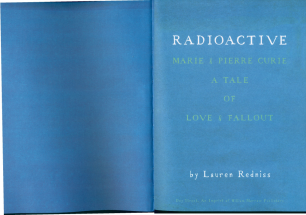
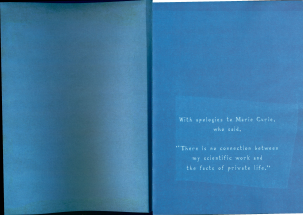
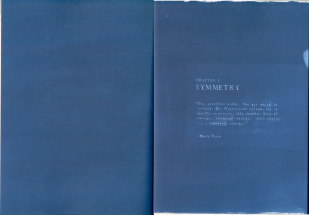
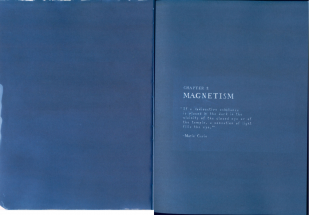
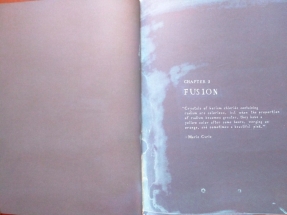
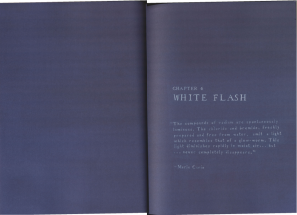
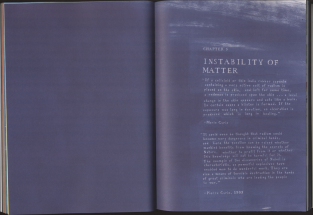
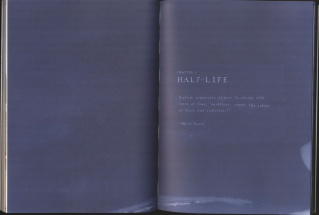
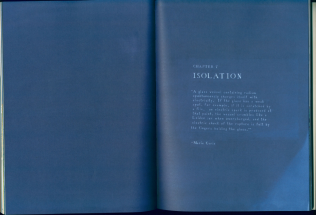
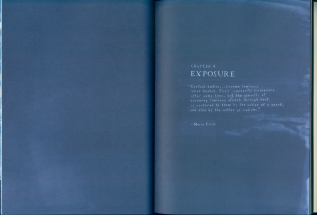
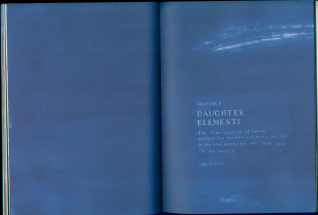
These chapter headings are all the “same” color in the real(?) world, that is, when you’re holding the book in your fleshy material hands and light is bouncing off the pages through your corneas (I don’t have access to good digitization equipment; these scans are not true to color). I say “same” because they were produced using the cyanotype method described below. This process produces colors that vary within a relatively narrow range, but whose ultimate outcome depends upon the fickle exposure conditions. Interestingly, Redniss did not use a cyanotype negative to produce the page on which she explains this printing process: [199]
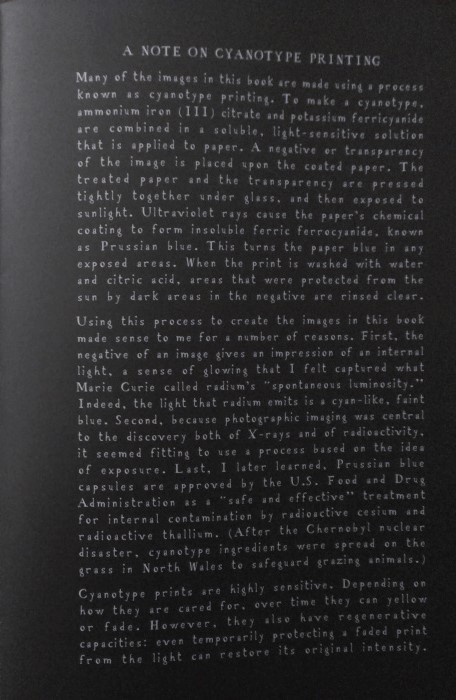
There’s not much meaning to be found digging around in the chapter headings, but they establish a pattern for more color encoding. The color coding creates an organizational structure separate from the chapter-divided structure. The pages of the first chapter and the first few pages of the second are set in all black and white (and maybe a little cream). It recounts Marya’s (Marie, in polish) and Pierre’s childhood and adolescent backgrounds. Integral to Redniss’s understanding of their upbringings is their relationship to young love and its sting. Pierre’s first love died under unknown circumstances; Marie’s was the scion of a sugar beet mill industrialist family, in whose employ she served as governess to save money for the Sorbonne. The family was aghast at the prospect of their son marrying a woman of much humbler birth; Marie was jilted and humiliated. Redniss makes sure the importance of the entwining of (lost) love and intellectual rigor doesn’t go unnoticed. They seem to play off one another in Marie’s and Pierre’s adolescences. They experienced love so acutely that they needed to bury themselves in their work or flee to the Sorbonne to avoid it. Perhaps the pages are rendered in black and white to signify the past, placing the bulk of the story in a situated “present”, relative to which Marie’s and Pierre’s adolescences are flashbacks, dulled by the insufficiency of memory into black and white — encoded this way in the manner inhabitants of the late 20th and 21st centuries have encoded the past in black and white because old photography, either with black or sepia, has come to stand in for the remedial visual memory of society. Or perhaps black and white because Marie’s and Pierre’s researches in their early years were focused on metals, minerals, crystalline structure, and magnetism, they’ve yet to be bombarded with intellectual radioactive curiosity. Perhaps later in the text, it is the presence of the radioactive material in their lives and in Redniss’s story, accordingly, which illuminates the pages with color. Perhaps, differently still, Redniss composed their backgrounds in black in white because they were still separated from one another, staving off the radioactively-amorous chain reaction that would surely result when they were eventually placed in contact: [14-21, 24-27]
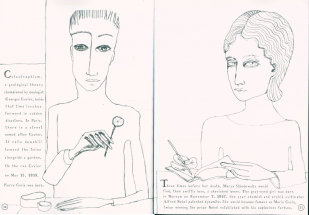
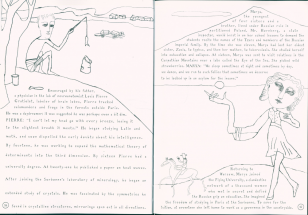
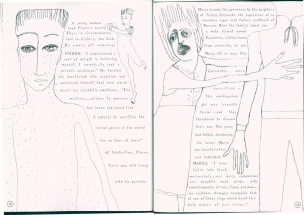
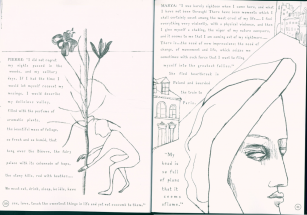
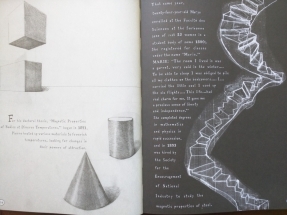
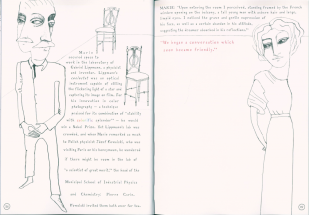
. . . Or maybe not so differently, the absence of color encodes both the absence of each other’s love and of inquiry into radioactivity. Redniss goes to great length to show the literal and metaphoric inextricability of their love for one another and their scientific investigations into radioactivity. When Marie and Pierre are introduced to one another, the walls glow, as they began a conversation “which soon became friendly”: [28-29]
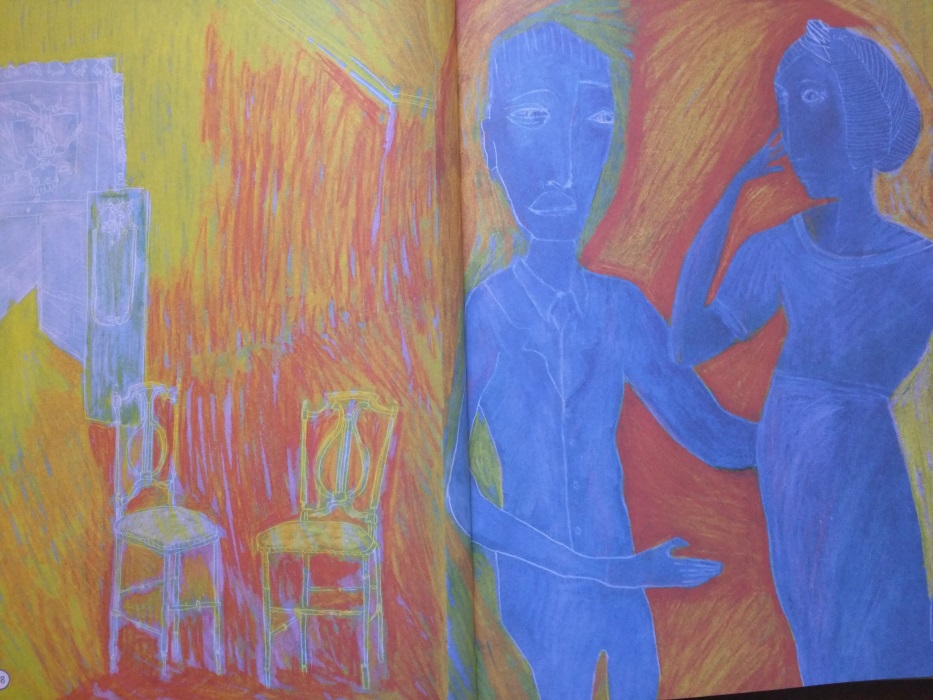
Not just specific color palettes, but color itself — the opposite of black and white — might code for radioactivity or love or both. Or it might more generally be seen to code for the fundamental forces of the universe. Like the quintessence in Luc Besson’s The Fifth Element, love in Redniss’s Radioactive might be coded as the fifth fundamental physical force. On the next page, mineral structures are colored representing their piezoelectric response to stress: [30-31]
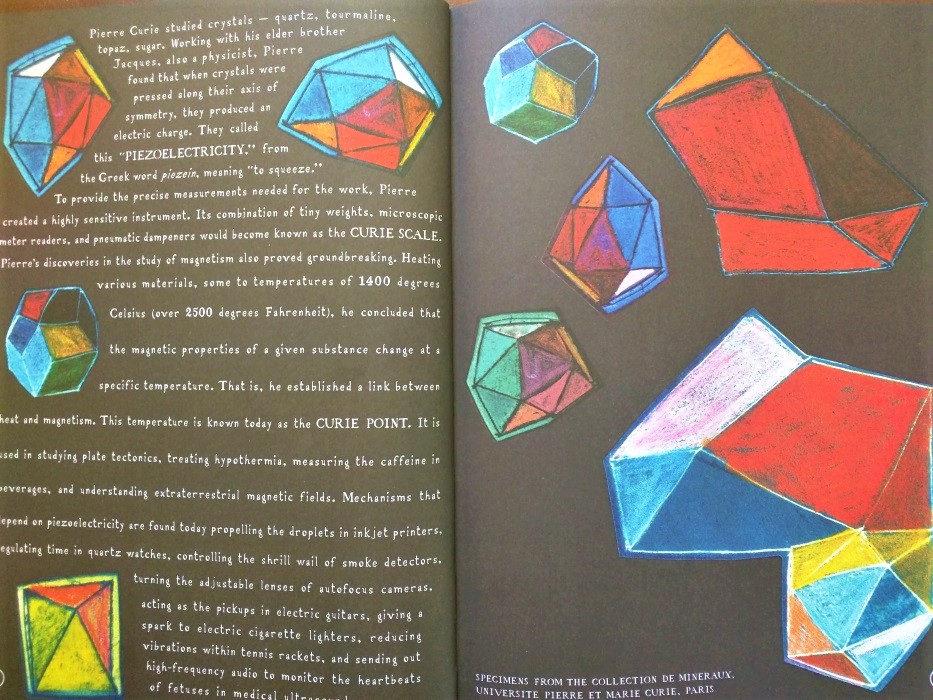
Marie and Pierre’s conversation “which soon became friendly” soon became friendlier. They began to work together in Pierre’s cramped lab. Though she longed to return to Poland, this desire was countered by the opposing magnetic force of her and Pierre’s increasing inseparability. This color section traverses the divide between chapters two and three, and in quick succession in three pages the reader sees “Chapter 3: Fusion” — “Marie gave birth to a six-pound baby girl” — “The young couple returned to the lab,” heightening the inextricability of Marie and Pierre’s scientific and romantic endeavors and re-inscribing the metaphorical connection between chemical and amorous radioactivity in their lives. In a laboratory scene depicting an electrometer Marie used to measure the intensity of radiation, the scene is instead dominated by Marie and Pierre making out in their lab. “Could this energy be harnessed?,” the adjacent description of her sciencey lab work asks. Turn the page to find a blossoming mushroom cloud bathing the frame in yellowish-golden light, perhaps refracted through the previous pages turning the stories of infatuation, marriage, childbirth, and scientific labor ochre and orange. [32-34, 38-41, 44-47]
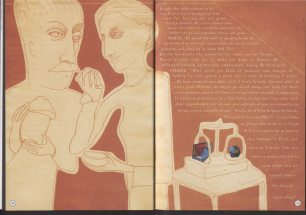
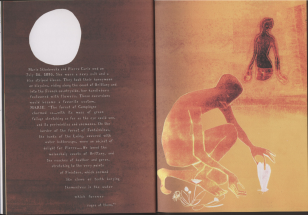
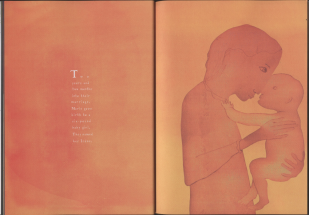
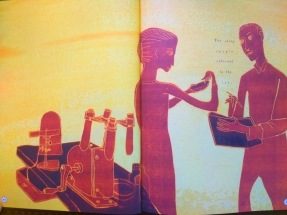
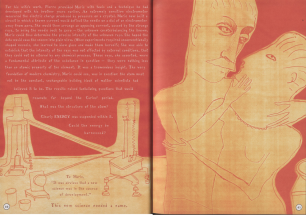
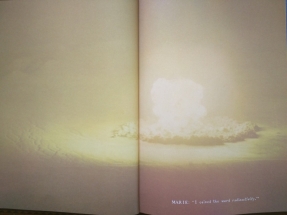
Also coded, again by the absence of color, are tangents into aspects of nuclear science. Their white backing sets them apart from the main narrative of the Curies (by this point in the text unfailingly colorful), but the details these tangents provide of various topics in nuclear science are not detached from the Curie’s scientific labor. The first aside depicts the luminescent fantasia of the dancer Loie Fuller [64-65]. Fuller collaborated with Edison to produce luminescent dance costumes from calcium deposits. She contacted the Curies to experiment with radium, but they could not part with their preciously-earned material (it took them four years, four hundred tons of water, and forty tons of processing chemicals to extract one-tenth of a gram of radium chloride [57]).
In another aside, Redniss traces the development of anti-cancer radiation therapy (what had once been called curiethérapie) back to a 1900 experiment in which Pierre lashed a tube of radium to his arm for ten hours (after 52 days there was still a grayish lesion where the test tube had been)[70-71].
In the aside detailing the horrors of the atomic bombings of Hiroshima and Nagasaki, Redniss provides the testimony of Sadae Kasaoka, who was a child in Hiroshima when the bomb was dropped. Sadae visually conveyed her experience of the bombing’s aftermath with black and red paper cutouts representing her father’s body and the way his skin peeled off of him [84-85]. The very next page jars the reader back to Marie and Pierre’s story line: they’re traveling to Sweden to collect their Nobel Prize when Pierre marveled “At the moment of our voyage, there was no night” [87], drawing a poignant contrast with Kasaoka’s experiences with nuclear science. Despite this narrative jump, the two seemingly disparate segments are connected by color, or, rather, colorlessness; what would have been in a traditional Curie biography the moment of singular triumph is rendered the plainest in Redniss’s recounting — the type is as small as a publisher will allow and is dwarfed by its association — established by color encoding — with the atrocities of Hiroshima.
The horrors are continued in Redniss’s recounting of the 800 or so young women and girl wage laborers tasked with coating watch dials with the radium-infused “Undark” paint for U.S. Radium Corporation. The brushes they used to fit watch dials were only three or four horse hairs wide and to keep them to point, the young women and girls would twirl them between their lips, resulting in decomposing jaws, bleeding gums, and anemia. The plant is now a superfund site. In this aside Redniss also relates to the reader the story of ex-KGB operative Alexander Litvinenko who was poisoned most conspicuously and least efficiently with radioactive polonium 210, named by Marie after her longed-for home country. Redniss embellishes these asides with the image at right. I would like to know how she came to create this image.
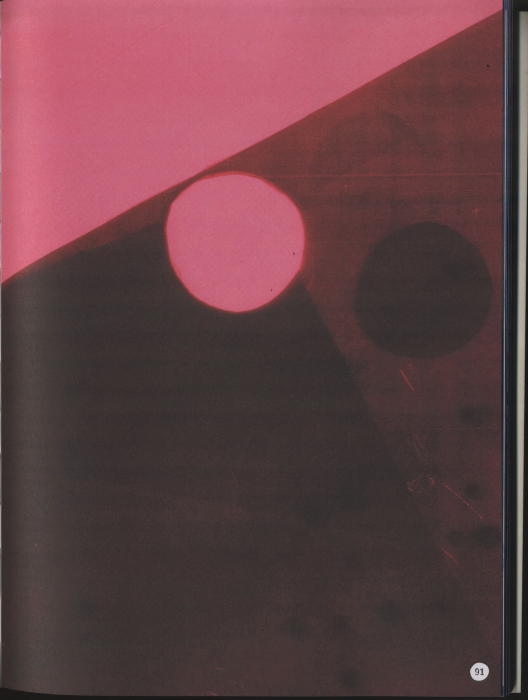
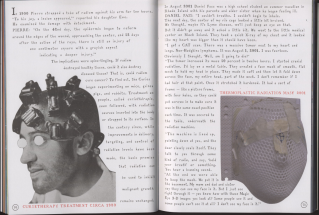
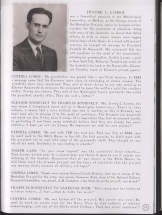
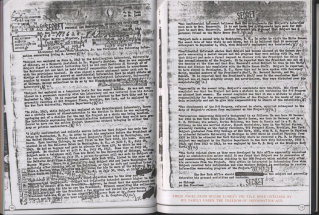
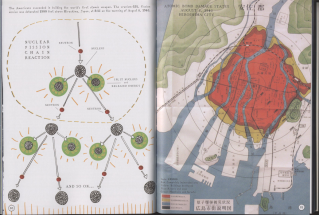
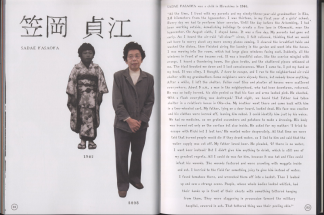
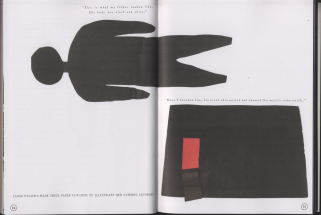
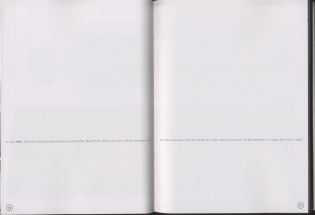
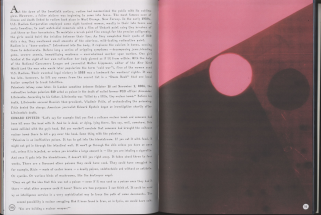
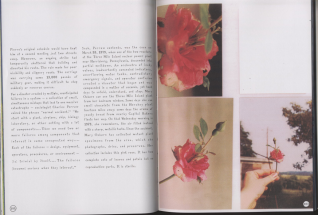
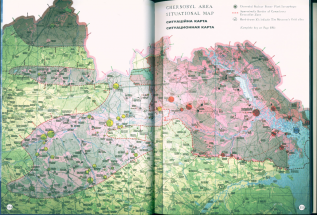
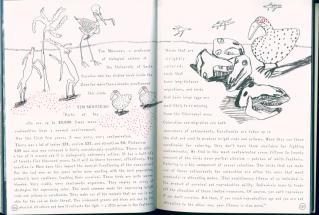
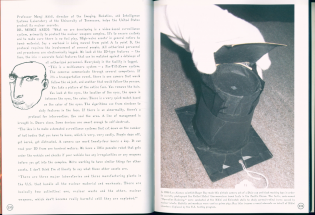
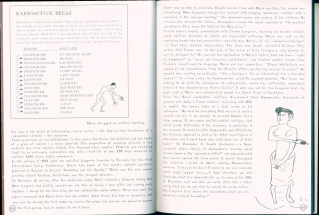
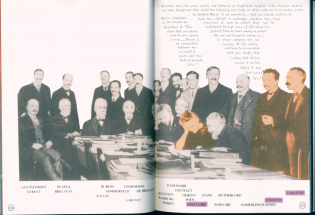
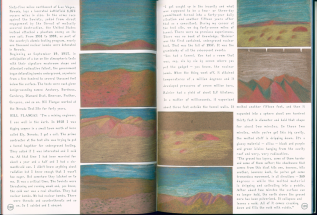
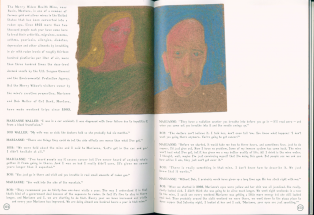
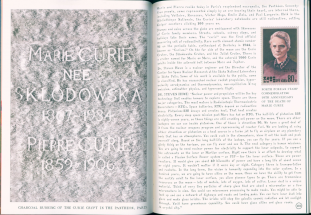
Besides the chapter pages, there is a second string of pages colored with the cyanotype method. They come in several discontinuous bursts and so cannot represent a chronological period in the Curies’ life. Instead, they represent the mingling of love and nuclear science. The first cyanotype spread [58-59], building off the lead-in paragraph from the previous page (“With the constant companionship that accompanied their research, the Curies’ love deepened. They cosigned their published findings. They handwritings intermingle in their notebooks. On the cover of one black canvas laboratory log, the initials ‘M’ and ‘P’ are scripted directly one atop the other.”), simply reads “We lived in a preoccupation as complete as that of a dream,” referring both to their love and their study of radiation.
The very next spread begins to cue the reader into the visual association between the glow of radium and the ethereal fades between white and blues of the cyanotype process [60-61 (though, admittedly, it is difficult to discern if this spread was produced using cyanotype printing or in some other medium designed to closely replicate the cyanotype aesthetic). It describes the “fragile glow of radium” that “offered a retreat into forgiving shadows and candlelit intimacy” in contrast to the stark “horror” of the overly bright incandescent bulbs of the time. This echoes the description from the Chapter 4 epigraph, quoting Marie, which describes the spontaneous luminosity of radium chloride and radium bromide solutions, emitting a light resembling that of a glow-worm, and not unlike a solute admixture of love and radiation science. In this symbolic scheme, the cyanotype process replicates the soft otherworldly glow of radium — the deep blues on the page a remediation of the Curies’ blacked out laboratory shed illuminated like night-sky indigo by radiation in the visible spectrum.
The next sequential burst [between 95 and 102, exclusive] depicts Pierre’s death. His skull was crushed by the rear wheel of a horse-drawn carriage after it had knocked him to the ground while he attempted to cross the street. None of the six pages are paginated — a moment out of conjunction with time — unplottable on the number line of Redniss’s text. The Curie’s life of mind and love now as inverted as the cyanotype plate for what would be pages 98-99: cyan inscription on white background, rather than the other way around — a photonegative of a shared life — a “half-life,” as the chapter title calls it. When they’re carrying his corpse from the street, it glows like a tube of radium chloride. With Pierre dead the reader expects the cyanotype coloring to stop. And it does, for a while, until Marie moves their daughters to Sceaux, outside of Paris, to be near Pierre’s father, and where Marie could take up Pierre’s unfinished research. And the cyanotyping stops again.
But then it comes back again — but how? “Four years after the death of her husband. Marie had fallen for Pierre’s former student, physicist Paul Langevin” [122, 124-25]. In a new erlenmeyer flask, to be sure, but love and radiation science mingled once again. And so did their bodies, in what might be considered the most intense chromatic complement of the cyanotypic hues [at right].
And then it disappears again.
Nearly a quarter of the book goes by before a familiar phrase catches the reader’s eye: “Time magazine wrote: ‘Husband and wife work like one person with two heads, four hands, 20 fingers'” [165]. Marie and Pierre? No. Marie and Paul Langevin? No. Frederic Joliot and Irene née Curie. Frederic was trained by Langevin and Irene by Marie. Together they generated a now thrice-confirmed natural phenomenon: “He began walking her home from the lab in the evening. On October 4, 1926, they married. It was not long before their union echoed the double partnership — romantic and scientific — of their mentors” [164].
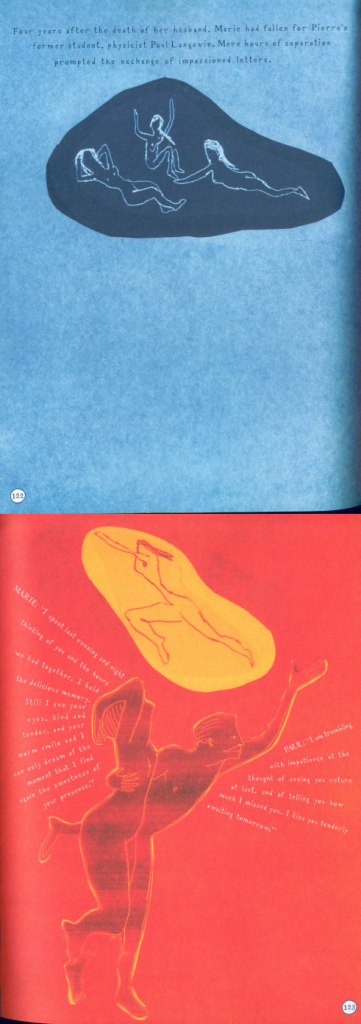
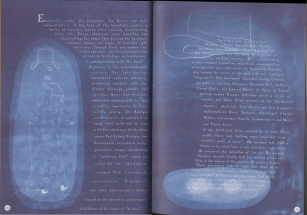
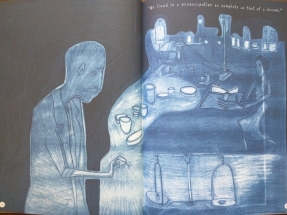
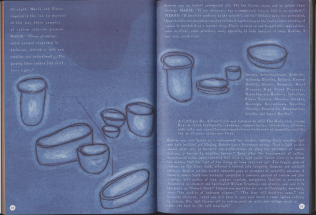
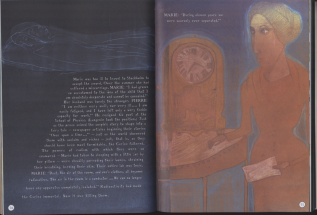
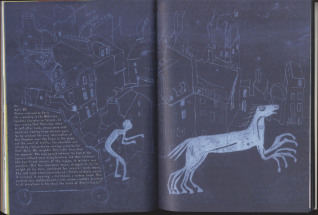
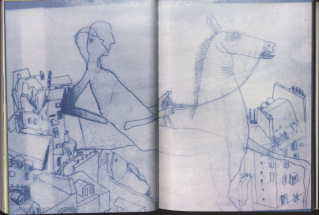
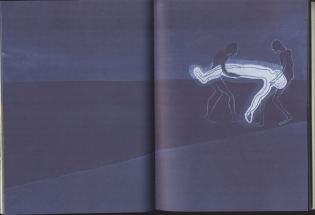
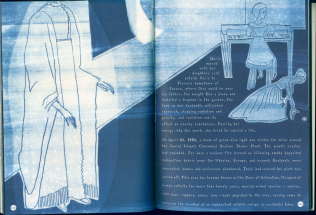
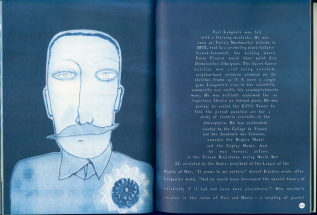
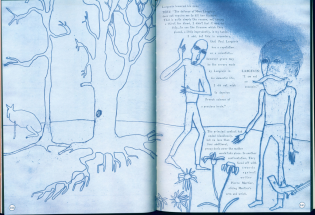
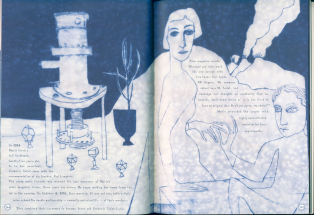
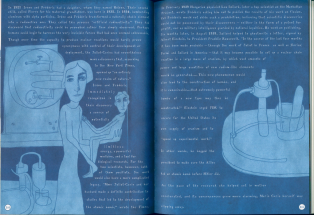
Redniss established the color coding motif with the chapter title pages. She used it in the white sequence to signify a break from the biographical narrative of the Curie family, tangentially venturing into radiation therapy, radioactive assassination, nuclear weaponry, nuclear reactor meltdown, and radiation-induced genetic mutation and physical deformity. Contrary to the colloquialism, tangents are not unrelated to the (narrative) arcs from which they deviate, but can only exist in accordance with their arcs. They can even be used reflexively to measure the trajectory of their arc, as is the case with the instances of fallout and the life of the Curies.
The cream and black, ochre and orange, and cyanotype color sequences consistently establish the inextricability of romantic love and scientific labor in the lives of the Curies. Like tangents, love is often considered inapplicable to the story of scientific progress. Romantic affect is construed as an impediment to scientific thought, or at best a distraction from it; fallout is considered a bastardization of scientific application. But, also like the colloquialism on tangents, Redniss illustrates (literally) the mutual interdependency between the three in color as much or more than in text.